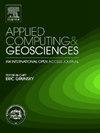复杂构造条件下断层网络的自动提取:一种混合机器学习和结构属性方法
IF 3.2
Q2 COMPUTER SCIENCE, INTERDISCIPLINARY APPLICATIONS
引用次数: 0
摘要
地震断层的解释对于勘探区生成、储层建模和二氧化碳储量评估至关重要。然而,在复杂的构造体系中识别断层仍然具有挑战性,特别是在经历了多期构造活动的地区。尽管在构造地震属性和机器学习方面取得了进步,但解释人员通常仍然依赖于人工方法来分析复杂的断层系统,例如在澳大利亚西北部Browse盆地的Poseidon研究区发现的断层网络,其中断层网络由伸展和挤压构造事件形成。本文介绍了一种将机器学习与地震结构属性相结合的混合方法,用于从三维地震数据中提取复杂断层网。该方法首先使用预训练的模型生成故障概率立方体,然后通过手动标记数据的重新训练来细化该立方体,以纳入局部结构知识。为了解决假阴性问题,使用从手动训练模型的故障概率立方生成的反跟踪体作为自动标记数据进一步重新训练模型。故障概率立方体由自动标记的训练模型重新生成,并通过抗跟踪等后处理技术进一步增强,以提高故障连通性,简化故障自动识别过程。这种混合方法可以有效地从三维地震数据中检测和提取主要和次要的不连续面,并且精度很高,与传统技术相比,显著减少了解释所需的时间和精力。本文章由计算机程序翻译,如有差异,请以英文原文为准。
Automated fault network extraction in complex tectonic regimes: A hybrid machine learning and structural attributes approach
Interpreting seismic faults is crucial for prospect generation, reservoir modeling, and CO2 storage assessment. However, identifying faults in complex tectonic regimes remains challenging, particularly in regions that have experienced multiple phases of tectonic activity. Despite advancements in structural seismic attributes and machine learning, interpreters often still rely on manual methods to analyze intricate fault systems, such as those found in the Poseidon study area located in the Browse basin, Northwestern Australia, where the fault network is shaped by both extensional and compressional tectonic events. This paper introduces a hybrid approach that combines machine learning with seismic structural attributes to extract complex fault networks from 3D seismic data. The method begins by using pre-trained models to generate a fault probability cube, which is then refined through re-training with manually labeled data to incorporate local structural knowledge. To address false negatives, the model is further retrained using an ant-tracking volume generated from the fault probability cube of the manually trained model as automatically labeled data. The fault probability cube is regenerated from the automatically labeled trained model and further enhanced by post-processing techniques, such as ant-tracking, to improve fault connectivity and streamline the automated fault identification process. This hybrid approach effectively detects and extracts both major and minor discontinuities from 3D seismic data with high accuracy, significantly reducing the time and effort required for interpretation compared to traditional techniques.
求助全文
通过发布文献求助,成功后即可免费获取论文全文。
去求助
来源期刊

Applied Computing and Geosciences
Computer Science-General Computer Science
CiteScore
5.50
自引率
0.00%
发文量
23
审稿时长
5 weeks
 求助内容:
求助内容: 应助结果提醒方式:
应助结果提醒方式:


